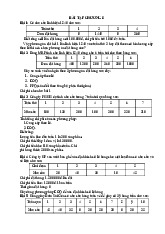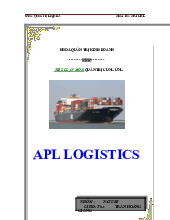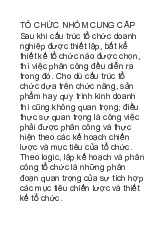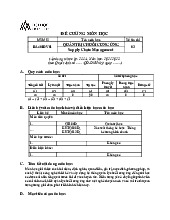


















Preview text:
lOMoAR cPSD| 47206521 Lecturer:
Ho Trung Thao (thao.hotrung@hoasen.edu.vn) 1 lOMoAR cPSD| 47206521 lOMoAR cPSD| 47206521 Learning Objectives
Appreciate the problems of considering logistics functions in isolation
Discuss the benefits of creating a single, integrated logistics function
Outline the steps needed for internal integration
Discuss the benefits of external integration along supply chains
Review the difficulties of achieving this external integration
Describe different types of external integration lOMoAR cPSD| 47206521 Outline
Problems with fragmented logistics
Bringing activities together
Integration along supply chains Achieving integration Types of co-operation
fragmented logistics : logistics bị phân mảnh/chia cắt
integration: tích hợp; co- operation: hợp tác lOMoAR cPSD| 47206521
1. Problems with fragmented logistics
Summary of logistics activities Procurement Inward transport Physical distribution Warehousing Outward transport Stock control returns Materials handling Picking Receiving Consolidating Suppliers Operations Customers Communications Location
consolidating : gom hàng
order picking: gom hàng cho đơn hàng lOMoAR cPSD| 47206521
Marketing wanted:
high stocks of finished goods to satisfy customer demands quickly
a wide range of finished goods always held in stock
locations near to customers to allow delivery with short lead times
production to vary output in response to customer orders
emphasis on an efficient distribution system
an optimistic sales forecast to ensure production was geared up for actual demand.
stocks finished goods: tồn kho hàng thành phẩm; leadtime: thời gian chờ hàng
sale forecast: dự báo mức tiêu thụ lOMoAR cPSD| 47206521
1. Problems with fragmented logistics
Fragmented Logistics has the disadvantages of:
- Giving different, often conflicting, objectives within an organization.
- Duplicating effort and reducing productivity.
- Giving worse communications & information flows between the parts.
- Reducing co-ordination between the parts – leading to lower
efficiency, higher costs & worse customer service.
- Increasing uncertainty & delays along the supply chain.
- Making planning more difficult.
- Introducing unnecessary buffers between the parts (e.g. stocks of
WIP, additional transport & administrative procedures.
- Obscuring important information (e.g. the total cost of logistics).
- Giving logistics a low status within the organization.
conflicting objective: mục tiêu mâu thuẫn; duplicating effort: nỗ lực trùng lắp
WIP: work-in-process, work-in-progress: bán thành phẩm 7 lOMoAR cPSD| 47206521
2.Bringing activities together
To avoid these problems, logistics should:
❖ Integrating logistics within an organization has all
the related activities working together as a single function.
❖ be responsible for all storage and movement of
materials throughout the organization.
❖ tackle problems from the viewpoint of the whole
firm, and looks for the greatest overall benefit.
In practice, it is difficult to integrate all logistics within a firm.
tackle: giải quyết, xử trí (vấn đề)
Viewpoint: quan điểm lOMoAR cPSD| 47206521
2.Bringing activities together Stages in integration
The movement of logistics from low priority, fragmented function
strategic, integrated function, is a major change, which goes through the following stages:
1. Separate logistics activities that are not given much attention or considered important.
2. Recognizing that the separate activities of logistics are important
for the success of the organization.
3. Making improvements in the separate functions, making sure that
each is as efficient các hoạt động logistics riêng rẽ/phân tán 9 lOMoAR cPSD| 47206521
2.Bringing activities together
Stages in integration (cont’d.)
4. Internal integration – recognizing the benefits of internal
cooperation and combining the separate functions into one.
5. Developing a logistics strategy, to set the long-term direction of logistics.
6. Benchmarking – comparing logistics’ performance with other
organizations, learning from their experiences, identifying areas
that need improvement & finding ways of achieving it.
7. Continuous improvement – accepting that further changes are
inevitable and always searching for better ways of organizing logistics. 10
internal integration: tích hợp bên trong
benchmarking: so sánh với một chuẩn mực, chuẩn đối sánh Downloaded by thao trang (Vj11@gmail.com) lOMoAR cPSD| 47206521
2.Bringing activities together
Integration is difficult, with specific problems including
Finding a sponsor: someone with knowledge, enthusiasm, ability and
authority to carry out the necessary change.
Changing practices: people feel comfortable with established practices.
Organization: Different department have their central activities. They feel have little in common.
Cultural changes: A departmental organization is based on self-interest and
conflict, where each benefits at the expense of the others
Rewards: traditionally, performance measure and rewards are largely based on departmental achievement.
Information systems: traditionally built to support the specialized needs of
each department and are not integrated
Hoarding of resources: temptation for each department to hoard resources
to safeguard their position and act as a buffer against unexpected events.
hoarding: (đầu cơ) tích trữ
sponsor: người đảm nhiệm lOMoAR cPSD| 47206521 3.Integrating along the SC
❑If each organization only looks at its own operations, there
are unnecessary boundaries between them, disrupting the
flow of materials and increasing costs.
❑External integration removes these boundaries to improve the whole chain.
❑Christopher (1999) supports this move, saying “most
opportunities for cost reduction and/or value enhancement
lie at the interface between supply chain partners”.
This suggests three levels of integration: a) Distinct logistics activities
b) Internal integration to form a single function
c) External integration along supply chains
external integration: tích hợp bên ngoài lOMoAR cPSD| 47206521
a. Separate functions within an organization Logistics activities Supplie Su rs pplie Customers Operations Customer
b. Integration within the organization
Logistics with internal integration Suppliers Customers Operations
c. Integration along the supply chain
Logistics with external integration Suppliers Operations Customers lOMoAR cPSD| 47206521
Forrester (1961) described on interesting effect of fragmented SC. Imagine
▪ a retailer who notices that demand for a product rises by 5 units
in a week. When it is time to place the next order, the retailer
assumes demand is rising, and orders 10 extra units to make sure its enough.
▪ The wholesaler sees demand rise by 15 units, so it orders another 20 units.
▪ As this travels through the SC, a small change in final demand is
amplified into major variation for early suppliers.
variation: sự biến đổi lOMoAR cPSD| 47206521
The consequence of the separation of logistics
The Bullwhip effect ( hiệu ứng cái roi da)
Bullwhip Effect- the magnification of safety stocks and costs based on separate
forecasts and uncoordinated planning and sharing of information along the supply chain manufacturer distribution retailer wholesaler lOMoAR cPSD| 47206521 3.Integrating along the SC
Benefits of integration o Common objectives for all parts of
the supply chain and genuine co-operation to achieve these
objective. o Shared information, reduce uncertainty.
o Improved material flow, with co-ordination giving faster and more reliable movements
o Lower costs – due to balanced operations, lower stocks, less
expediting, elimination of time wasting or non value adding
activities, ... o Better customer service, with shorter lead times, and faster deliveries.
o Improved performance – due to more accurate forecasts, better
planning, higher productivity of resources, rational priorities, ...
Downloaded by thao trang (Vj11@gmail.com)




